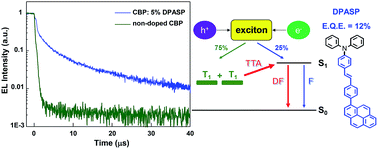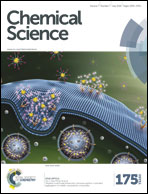Superior upconversion fluorescence dopants for highly efficient deep-blue electroluminescent devices†
Abstract
In this study, we revealed a new approach for the development of new triplet–triplet annihilation (TTA) materials with highly efficient deep-blue fluorescence via the incorporation of a styrylpyrene core and an electron-donating group. The resulting deep-blue emitters (PCzSP, DFASP, and DPASP) exhibit intramolecular charge transfer emissions with remarkably high emission quantum yields. The electroluminescent devices based on these three fluorophores as dopants using CBP as a host exhibit very high device efficiencies; in particular, the DPASP-doped device reveals an extremely high EQE of 12%, reaching the limit of a TTA-based device. The EL characteristics of DPASP-doped CBP-based devices at various doping concentrations (0–5%) suggest that the dopant DPASP is responsible for the TTA-type delayed fluorescence in the device; no delayed fluorescence was observed for the device using CBP as the host emitter. Moreover, when using DMPPP with ambipolar characteristics as the host, the deep-blue DPASP-doped device also gives outstanding performance with an EQE of nearly 11% with an extremely small efficiency roll-off, which was ascribed to the excellent charge balance in the emitting layer of the EL device. The TTA process of the SP-based dopants accounts significantly for the superior efficiencies of the EL devices.


 Please wait while we load your content...
Please wait while we load your content...